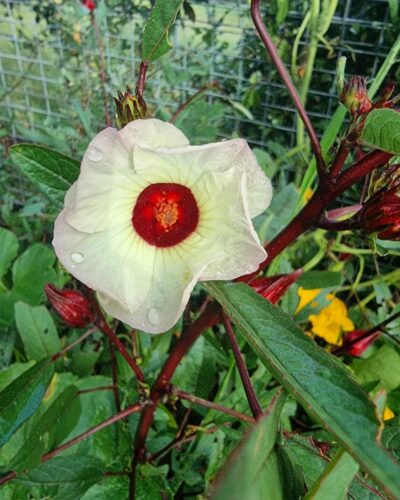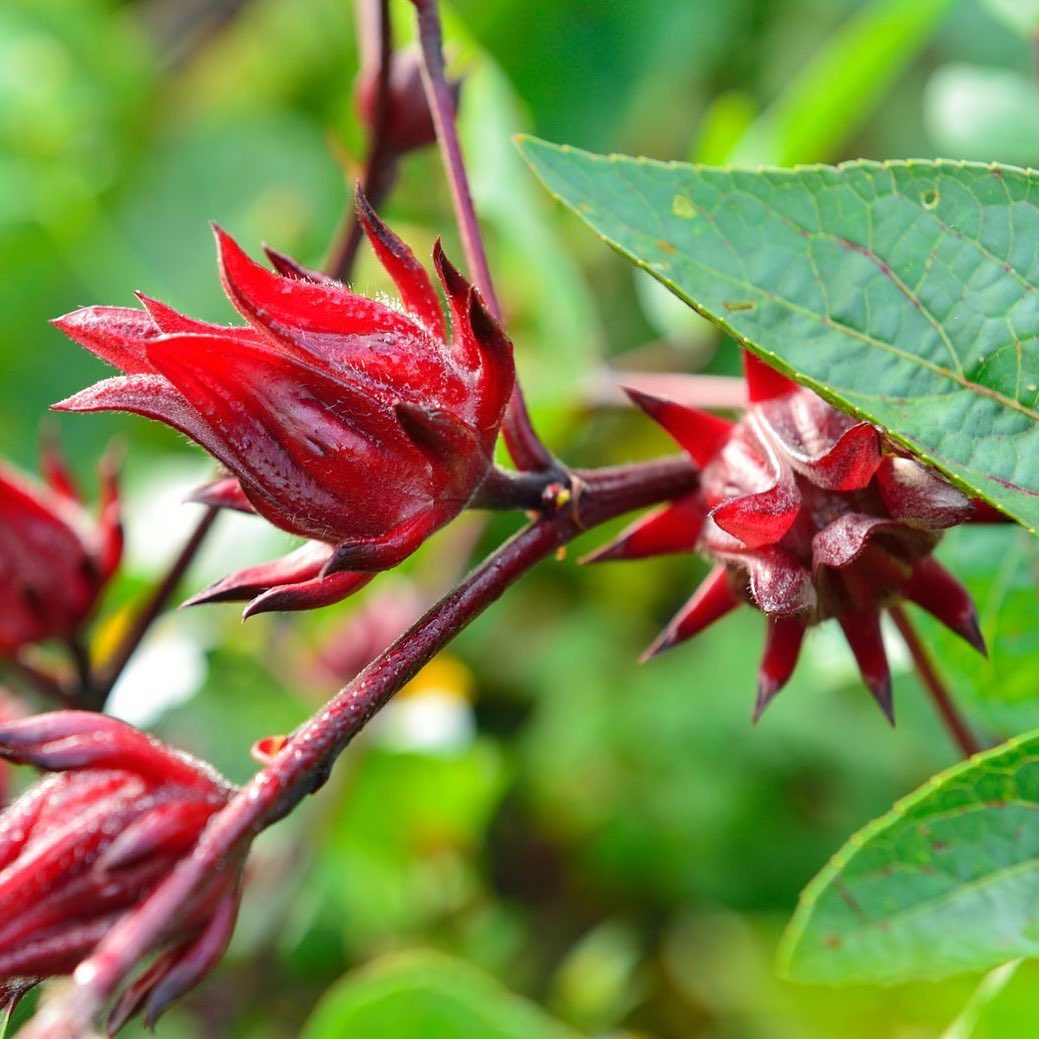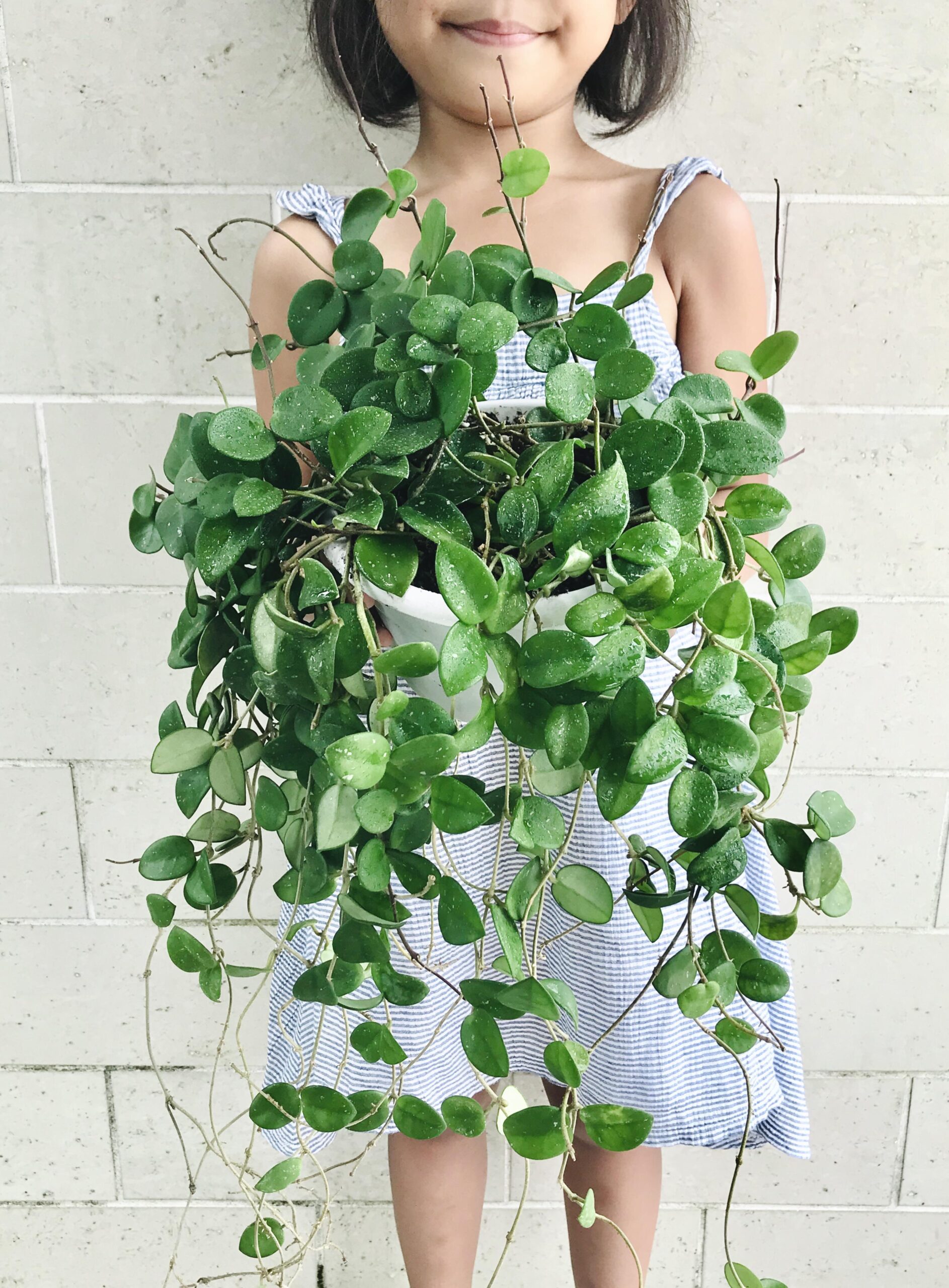Roselle Plant grows well in both containers or the ground due to its rapid germination rate. It features red-veined leaves and yellow blooms.
The striking red stems and red-veined foliage of the Roselle plant make a bold and colorful statement in any garden setting. This guide will surely help you in solving all your queries related to planting this plant with pretty hibiscus-like blooms.
Botanical Name: Hibiscus Sabdariffa
Common Names: October Hibiscus, Florida Cranberry, Indian Sorrel, Jamaican Tea, Maple Leaf Hibiscus, Red Sorrell, Roselle
USDA Zones: 8-11 (Perennial in zones 3-7)
Read: Roselle Plant Benefits and Uses
What is the Roselle Plant?

Also known as Maple-leaf hibiscus, Red Sorrel, and Roselle (Hibiscus Sabdariffa) is a Malvaceae family shrub. It originated in tropical Africa but is now widespread in tropical regions across the globe.
This versatile and edible plant is related to okra. It can grow up to 7 feet tall and features attractive foliage and flowers. It is highly valued for many uses, including medicinal and culinary. The red-green lobed leaves are used as a cooked green or added raw to salads for a tangy flavor.
In the month of October, the roselle plant offers yellow flowers with a dark center about 3 inches wide. The most popular part of the plant is the fleshy, bright red calyx at the bottom of each flower; it contains the seeds. This bright red calyx has a tart taste; it makes a good alternative to cranberries.
Hibiscus Sabdariffa (Roselle) Varieties
There are two varieties of Hibiscus sabdariffa:
- Hibiscus sabdariffa var. altissima Wester, which is primarily cultivated for its high-quality fiber
- H. sabdariffa var. sabdariffa, which is grown for food purposes.
When to Grow Roselle Plant
When the days become shorter, roselle begins flower production. This implies that regardless of when you plant roselle, you will not harvest its calyces before October at the earliest.
Regrettably, roselle is vulnerable to frost and may not produce any calyces in temperate zones. Nevertheless, in regions that do not experience frost, you can plant roselle in May and anticipate a continuous harvest of calyces from October to late February, as the collection of flowers stimulates new growth.
How to Propagate Roselle Plant from Seeds
- Before planting, make sure to scratch the bottom of the seed, as without seed meat, it cannot grow.
- If you live in a climate with uncertain spring weather or too much rain, plant hibiscus seeds in trays during early spring. Transfer them indoors if the weather becomes adverse.
- Wait until the seedlings are sturdy enough to withstand heavy rain before planting them in the garden. A strong rain can easily kill a new seedling. They should be about three inches tall before moving them outside.
- Hibiscus seeds usually germinate within ten days to three weeks after planting. Keep the soil moist but not wet by lightly watering the seeds after planting.
- Spray the seeds with a mist bottle three or four times per day.
Note: In regions classified as USDA zones 8-11, it can be cultivated from seeds. In regions as far north as zone 6, it is possible to grow roselle if started indoors and later transplanted outside.
Propagating Hibiscus Sabdariffa from Cuttings
- Dip the bottom of the hibiscus, cutting in the rooting hormone.
- Place the cutting in well-draining soil for rooting. A 50/50 mixture of potting soil and perlite is ideal.
- Keep the rooting soil moist.
Note: If you live in a cooler climate and lack a greenhouse or indoor space, adjust the planting time to avoid temperatures below 40°F, which can kill Hibiscus sabdariffa. In frost-prone areas, planting in-ground may not be feasible. If you are doubtful, plant hibiscus in pots.
Read: Red Spider Lily Growing Tips
Ideal Growing Conditions for Roselle Plant

Location
It’s important to note that roselle plants don’t thrive in shady conditions and require abundant sunlight to grow well.
Soil
To ensure adequate drainage, it’s necessary to amend the soil so it doesn’t hold onto water. If the soil on your property doesn’t drain well, you’ll need to modify the planting area by incorporating a mixture of sand and peat moss, adding a few inches of it. A recommended ratio for the mixture is two parts soil, 1 part peat moss, and 1 part sand.
Water
Water the soil only when it feels dry to the touch. Remember to add just enough water to make the soil moist without saturating it.
Roselle Plant Care
Fertilizer
Use a fertilizer with low levels of phosphorus, moderate amounts of nitrogen, and high levels of potassium; take a 17N – 5P – 24K ratio. Apply the fertilizer every two to three weeks. If the leaf tips turn brown, it’s a sign of excess nitrogen and stress. Don’t worry; simply trim the affected leaves and adjust the frequency of fertilization.
Pruning
Prune the roselle plant early to promote branching and encourage the growth of additional flowering shoots.
Pests and Diseases
When growing Roselle, the primary pest to watch out for is the root-knot nematode. In order to minimize the risk of nematode infestation, experts recommend practicing crop rotation. Additionally, aphids, whiteflies, mealybugs, and ground bugs can also be problematic.
Read: Salsify Care in Pots
Harvesting
It’s important to plan the harvest of Roselle before the temperature drops below 40°F. The plant typically starts blooming after 4-5 months as the days shorten, and the calyces are usually ready for harvesting in October or November.
Pick the calyces when tender and plump, as they will remain fresh for approximately one week. Harvesting also stimulates the growth of additional flower buds. With proper care, a single Roselle plant can yield up to 12 pounds of fruit.
Tip: When tender, it is easy to remove Roselle calyces from the plant by hand. However, if you wait until they harden, you may need to use pruners to detach them from the plant.
Hibiscus Sabdariffa Uses

In 1920, three new edible varieties of Roselle were introduced and named: ‘Archer,’ ‘Rico,’ and ‘Victor.’
For instance, roselle can make a “cranberry” sauce alternative by using chopped calyces instead of cranberries. The sauce should be kept refrigerated and consumed within a few days.
In the Caribbean, roselle is used to make a festive Christmas drink. Bakers can also use roselle instead of rhubarb when making fruit crisps or pies. The protein-rich seeds can be roasted and brewed like coffee or ground and added to soups and salads.
The nutrient-rich calyces can be stored frozen or dried for making cordials, punches, jams, and herb teas.
Tip: It is important to harvest the calyces before they turn brown on the plant and to separate them from the seeds before using them in recipes.



